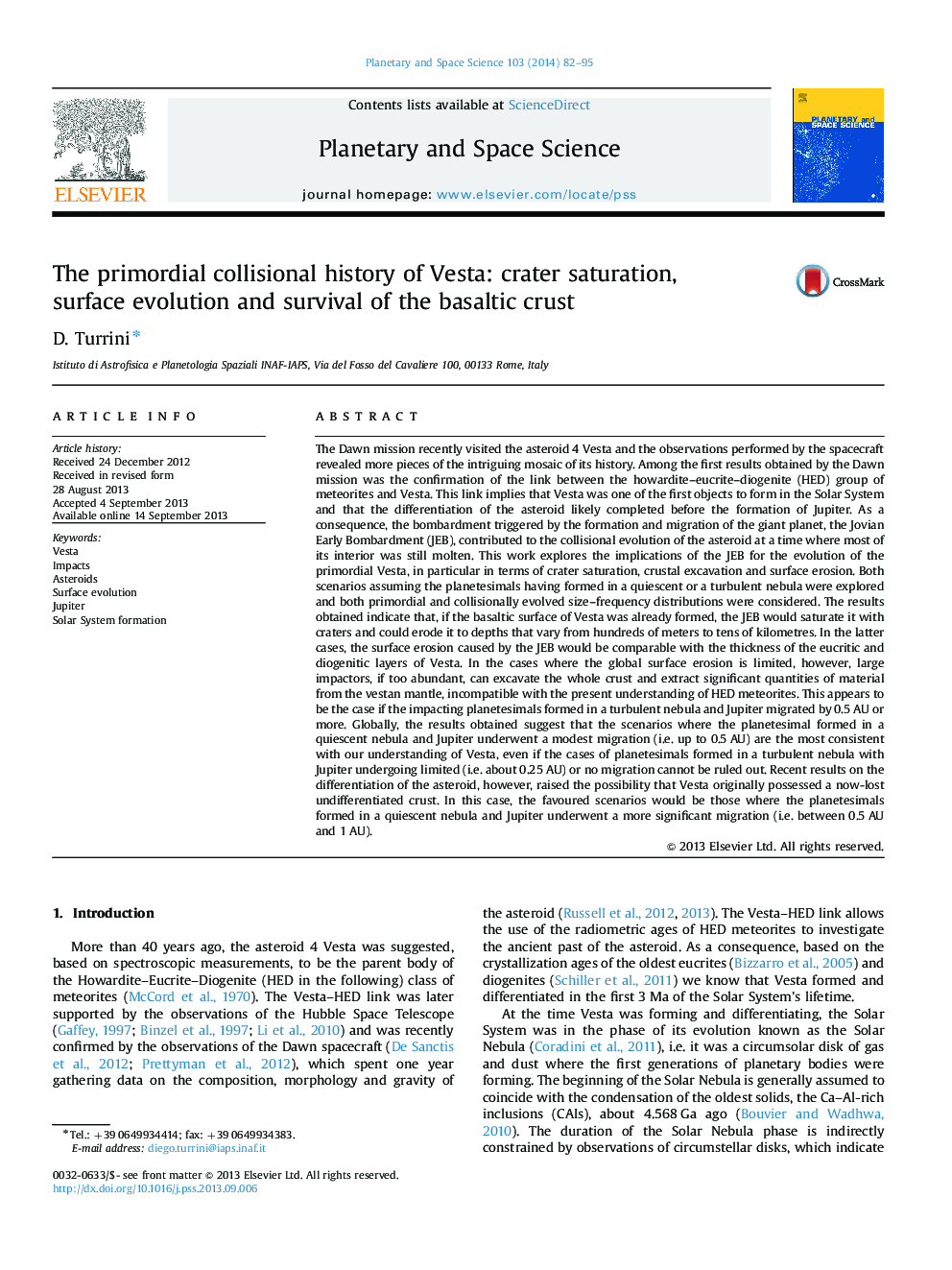| کد مقاله | کد نشریه | سال انتشار | مقاله انگلیسی | نسخه تمام متن |
|---|---|---|---|---|
| 8143429 | 1523934 | 2014 | 14 صفحه PDF | دانلود رایگان |
عنوان انگلیسی مقاله ISI
The primordial collisional history of Vesta: crater saturation, surface evolution and survival of the basaltic crust
ترجمه فارسی عنوان
تاریخ وقوع اولیه وستا: اشباع دهانه، تکامل سطح و بقای پوسته بازالت
دانلود مقاله + سفارش ترجمه
دانلود مقاله ISI انگلیسی
رایگان برای ایرانیان
کلمات کلیدی
وستا، تأثیرات سیارک ها، تکامل سطح، سیاره مشتری، شکل گیری سیستم خورشیدی،
موضوعات مرتبط
مهندسی و علوم پایه
علوم زمین و سیارات
فیزیک زمین (ژئو فیزیک)
چکیده انگلیسی
The Dawn mission recently visited the asteroid 4 Vesta and the observations performed by the spacecraft revealed more pieces of the intriguing mosaic of its history. Among the first results obtained by the Dawn mission was the confirmation of the link between the howardite-eucrite-diogenite (HED) group of meteorites and Vesta. This link implies that Vesta was one of the first objects to form in the Solar System and that the differentiation of the asteroid likely completed before the formation of Jupiter. As a consequence, the bombardment triggered by the formation and migration of the giant planet, the Jovian Early Bombardment (JEB), contributed to the collisional evolution of the asteroid at a time where most of its interior was still molten. This work explores the implications of the JEB for the evolution of the primordial Vesta, in particular in terms of crater saturation, crustal excavation and surface erosion. Both scenarios assuming the planetesimals having formed in a quiescent or a turbulent nebula were explored and both primordial and collisionally evolved size-frequency distributions were considered. The results obtained indicate that, if the basaltic surface of Vesta was already formed, the JEB would saturate it with craters and could erode it to depths that vary from hundreds of meters to tens of kilometres. In the latter cases, the surface erosion caused by the JEB would be comparable with the thickness of the eucritic and diogenitic layers of Vesta. In the cases where the global surface erosion is limited, however, large impactors, if too abundant, can excavate the whole crust and extract significant quantities of material from the vestan mantle, incompatible with the present understanding of HED meteorites. This appears to be the case if the impacting planetesimals formed in a turbulent nebula and Jupiter migrated by 0.5Â AU or more. Globally, the results obtained suggest that the scenarios where the planetesimal formed in a quiescent nebula and Jupiter underwent a modest migration (i.e. up to 0.5Â AU) are the most consistent with our understanding of Vesta, even if the cases of planetesimals formed in a turbulent nebula with Jupiter undergoing limited (i.e. about 0.25Â AU) or no migration cannot be ruled out. Recent results on the differentiation of the asteroid, however, raised the possibility that Vesta originally possessed a now-lost undifferentiated crust. In this case, the favoured scenarios would be those where the planetesimals formed in a quiescent nebula and Jupiter underwent a more significant migration (i.e. between 0.5Â AU and 1Â AU).
ناشر
Database: Elsevier - ScienceDirect (ساینس دایرکت)
Journal: Planetary and Space Science - Volume 103, 15 November 2014, Pages 82-95
Journal: Planetary and Space Science - Volume 103, 15 November 2014, Pages 82-95
نویسندگان
D. Turrini,
